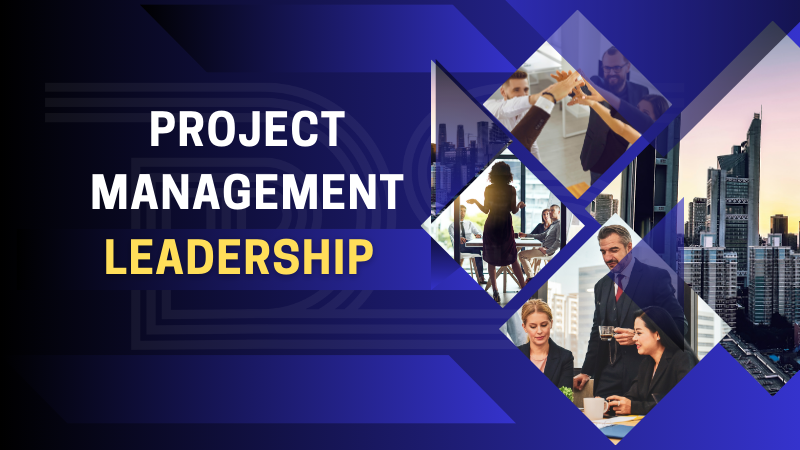
by DharamCW | Sep 26, 2024 | Leadership in Project Management
Project management is becoming an essential component of modern business operations. Organizations increasingly use project management to monitor and assess projects and ensure they meet their objectives. Project management entails several complex processes, including project planning, organization, management, control, budgeting, monitoring, testing, and implementation.
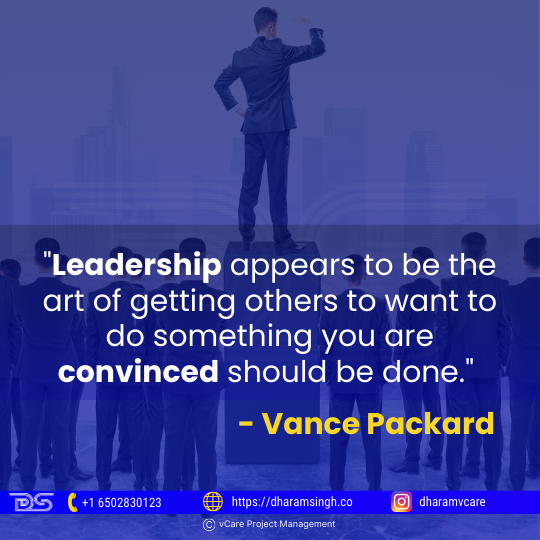
Vance Packard Quote
Project leadership is the art and science of guiding a team to successful project completion. When project leadership brings people together to work toward a similar objective, the team can do more than they could individually.
Project Management Leadership
Leadership in project management is a necessary ability for completing the project. Like in other business areas, leadership necessitates demonstrating several talents and behaviors in a project context. Leadership is essential to ensure the success of the projects, from team leadership to project governance.
Leadership and project management are closely intertwined. Setting the vision and encouraging the team to work together to accomplish the project goal are vital components of leadership. In a project environment, this is particularly significant. Delivering any project requires a team effort. While some teams work without a clear leader, in business, it is customary for someone to be in the leadership role, guiding and directing the team toward their goals. On the other hand, project management systematically applies processes, methods, knowledge, skills, and experience to achieve the project objectives. Effective project management often requires strong leadership to guide the team through the project’s complexities and challenges.
5 Essential Project Leadership Skills
Project managers execute allocated project tasks through their project teams. They learn the technical, business, and leadership skills to manage their project teams effectively. In addition, they use strong leadership skills to motivate their teams to complete project deliverables and achieve project goals.
Project managers’ essential leadership skills begin with encouraging and inspiring their teams. However, the five critical project leadership skills are equally vital in enhancing team performance.
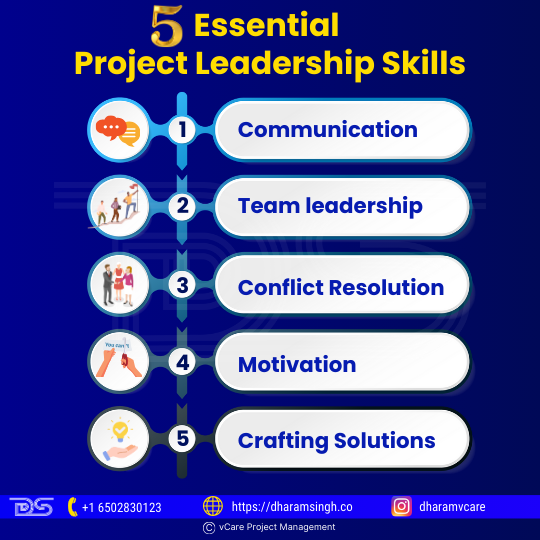
5 Essential Project Leadership Skills
- Communication
One of the most important project management skills is communication. Leaders must communicate effectively because a significant portion of their work includes collaboration. If you can communicate, you can collaborate properly.
Leaders can communicate ideas to people and groups in person, over the phone, or via web conferencing. They can also present their ideas to ensure the message is shared and understood. However, communication is more than just passing on messages and conversing with people. Communication is one of the most important characteristics of a project manager, especially in a leadership role.
- Team leadership
The leader establishes the vision and motivates others. Someone with outstanding project leadership skills fosters team agreement and togetherness while managing day-to-day operations.
Team leadership on projects entails establishing an environment in which everyone may thrive. People are lured to the project culture that surrounds them. Stakeholders want to be part of the project because they know you will complete the task while creating a pleasant working environment.
- Conflict resolution
Conflict is unavoidable when introducing or modifying something. However, effective leaders understand how to use conflict to their advantage since the finest solutions emerge when ideas are challenged.
Conflict may benefit teams by allowing all voices to be heard and opposing viewpoints to be expressed, frequently resulting in a better solution and more successful project outcomes. However, leaders must be equipped with conflict resolution skills to recognize and address conflict before it becomes a problem for the team. Therefore, another crucial core competency of project management is dealing with conflict in various ways.
- Motivation
Leaders motivate others to act even when they are not technically in charge. As a project manager, one determines what makes the other team members feel they’re giving their best. The project leader should do their best to deliver this. Everyone is driven differently, and motivation changes over time. Great leaders see these disparities and establish a great work environment to enable their workers to achieve their full potential.
- Crafting solutions
Empowering the team and the larger stakeholder community to participate in developing solutions is part of fostering a positive working culture. That entails removing roadblocks so that each team member may fulfill their work and contribute new ideas without concern about something getting in the way.
Empowering leaders also allows them to make decisions down the hierarchy to the lowest feasible level, allowing specialists to judge the solutions required to keep the project going. This empowerment fosters a positive working culture and inspires team members to take ownership of their work and contribute to the project’s success.
Leadership Styles and Theories
There is no single style to leadership, nor is there a particular type of person who makes a great leader. Instead, according to project leadership theory, a great leader is a mix of traits and the capacity to adapt to diverse conditions. This adaptability reassures individuals that leadership is not a fixed trait but a skill that can be developed and enhanced.
Leadership is something one can learn, and one can enhance one’s talents by understanding leadership theories in management. The three basic leadership theory categories that apply to project delivery are:
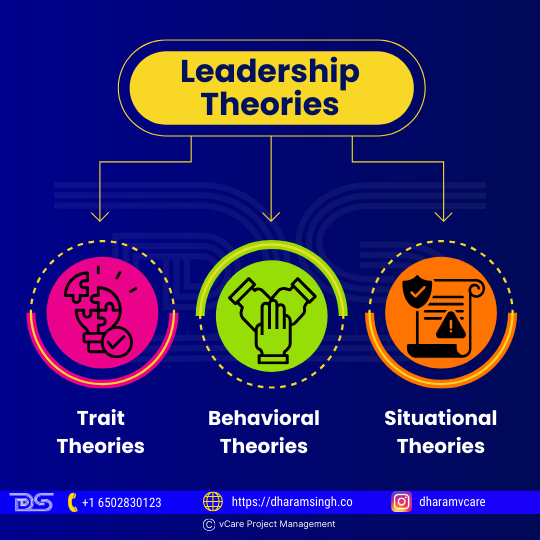
Leadership Theories
- Trait theories
Project manager strengths are related to trait theories. This perspective on leadership identifies the abilities and attributes that are beneficial while leading a team. Resilience, honesty, trustworthiness, aggressiveness, and so on are examples.
There was a system of thinking that stated certain characteristics were innate and that you were either born with them or not. Fortunately, this notion is no longer present in leadership concepts and theories. We know that an individual can act to become more aggressive and resilient or develop any other leadership trait.
- Behavioral theories
Behavioral leadership theories concern what a leader does. For example, some Corporate leaders are dictatorial and make decisions without consulting their employees. Others are more collaborative, inviting feedback and empowering their employees.
Both strategies are acceptable, and any combination of the two. However, there is a time and place for every style: you wouldn’t expect a combat leader to order a huddle so the team could discuss possibilities, would you? In that case, a choice must be taken immediately. Thus, a collaborative, listening leadership style would better engage the community.
- Situational theories
Situational leadership is deciding which leadership style to employ in any given scenario. These leadership theories are often known as contingency theories.
They analyze whether using a task-based or a people-based approach is more effective. They also take into account the individuals you lead. What type of encouragement and support do they require? A leader tailors their leadership style to the demands of the team, the business environment, and project circumstances. Someone who has never done specific work before will require more hands-on assistance from their team leader than someone confident in completing that activity.
Project Management Leadership Styles
Leadership in project management is essential for success. A project is a substantial and necessary endeavor in any business organization that requires full concentration and dedication from all participants. The success or failure of any business project can influence the company’s path. Project management is a critical role that may be entrusted to anybody, especially in today’s technology-driven business environment, where change is inescapable.
The ultimate success of every project is determined by project leaders, who have the authority to manage and oversee all project activities and make critical project choices. Similarly, failure to accomplish project objectives is the responsibility of the project’s leaders or management. Failure or inability to use the authority conferred upon them to ensure the project’s success is regarded as a point of accountability.
It is important to note that any project a firm does should strive to achieve certain goals that will enhance business operations and increase profitability, performance, output, and overall success in its objectives. As a result, project management is a critical function that leaders and anybody charged with project leadership must take seriously and utilize their effective leadership skills to ensure success.
Here are the six important project management leadership styles.
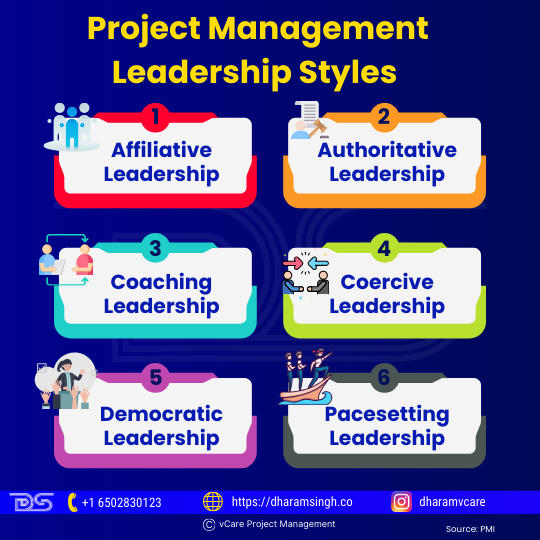
Project Management Leadership Styles
- Affiliative Leadership
This leadership style has a positive impact on a project team. This leader aims to create emotional bonds inside the organization to generate a sense of belonging and connection. When teammates require personal assistance or the team has to rebuild trust, the affiliative strategy is most successful. Because a single focus on praising and nurturing may result in poor performance and a lack of direction, this strategy should be used in various ways.
- Authoritative Leadership
Authoritarian leaders generate an entrepreneurial spirit and a strong devotion to the cause. Moreover, the traditional method works effectively when the team needs a new vision owing to changing circumstances or when clear guidance is unnecessary. Therefore, more utilization of this style would result in better project team outcomes without negative consequences, as this style has a generally positive effect throughout the organization.
- Coaching Leadership
This project management approach encourages team members to expand their capacity and capability as project contributors, which benefits the whole project team. This approach is the most effective coaching technique when a leader wants to assist colleagues in creating long-term personal characteristics that will help them succeed. However, it falls short when teammates are relentless about staying the same or learning or when the leader needs more aptitude.
- Coercive Leadership
Project managers rarely use this tactic, which would be more evident in times of crisis, such as when a project deadline was approaching and at risk of being missed.
- Democratic Leadership
This leader achieves successful compromises through teamwork. In a PMO, for example, each team member contributes to defining and measuring the PMO’s objectives. When the leader wants the team to buy into or own a decision, strategy, or goal, or when they are unsure and need new ideas from competent colleagues, the democratic method works well.
- Pacesetting Leadership
This leader anticipates self-management. The pacesetting approach works most effectively when the team is already motivated and talented and the leader demands quick results. This approach is popular, especially when a project nears major milestones. Although this method generally harms project teams, it can be beneficial in some situations.
Impact of Good Leadership on a Project
Many studies have highlighted leadership as one of the key reasons for project failure. On the other hand, projects with strong leadership and organizational support outperform those without.
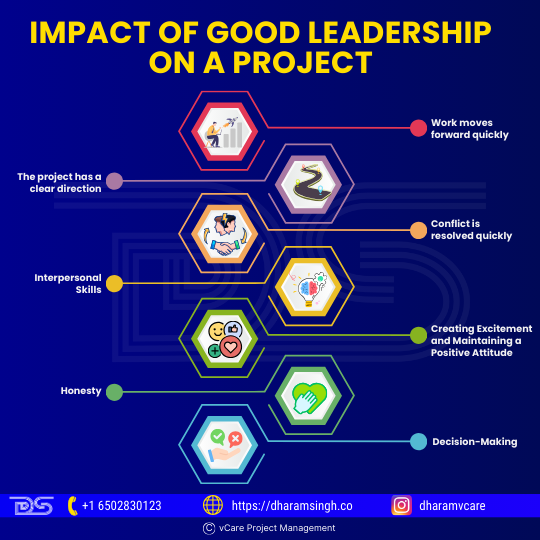
Impact of Good Leaders on a Project
- Work moves forward quickly
When an individual actively leads, the work proceeds quickly as the choices are made on time. This move allows the project to be completed on schedule while delivering all planned project scope elements.
- The project has a clear direction
A leader ensures that the team knows and supports a common goal. A clear direction gives context for decision-making and ensures that everyone knows what the project will deliver.
- Conflict is resolved quickly
The project leader is constantly looking for conflict and can intervene to handle it before it escalates into a crisis.
- Interpersonal Skills
Project leaders must have interpersonal skills such as questioning, listening, and speaking to establish successful and compelling interactions with team members.
Experts in project management believe that projects are more likely to fail if project managers lack excellent interpersonal skills. Because much of a project manager’s duties involve communicating with stakeholders, one must have great interpersonal skills to lead from the front.
- Creating Excitement and Maintaining a Positive Attitude
The most crucial project manager leadership skills are boosting team members’ enthusiasm and displaying an optimistic attitude, especially in times of crisis. In addition, project management and leadership are about instilling trust in teams that there will always be a solution, no matter how serious a situation is.
- Honesty
When defining ethical guidelines and supporting transparency in communication, project manager leadership skills should embrace honesty.
Honesty and integrity are two fundamental traits of project management leadership that project managers should cultivate to increase trust among customers, members, management, and other stakeholders.
- Decision-Making
The project manager has the last say in simplifying processes and solving difficulties. As a result, the project manager’s capacity to make informed judgments is a critical function of leadership in project management.
Decision-making is an important project manager leadership skill that directly influences project outcomes. Therefore, to advance in their careers, all prospective project management professionals must master decision-making abilities.
Leadership mindsets are driving the new economy
Mindsets are mental maps that reflect and govern how individuals act in organizations. They convey how individuals work and what they stand for. So, what leadership characteristics do respondents and experts believe are necessary for success in the digital economy? World Economic Forum survey data states four leadership mindsets driving the new economy: producers, investors, connectors, and explorers.
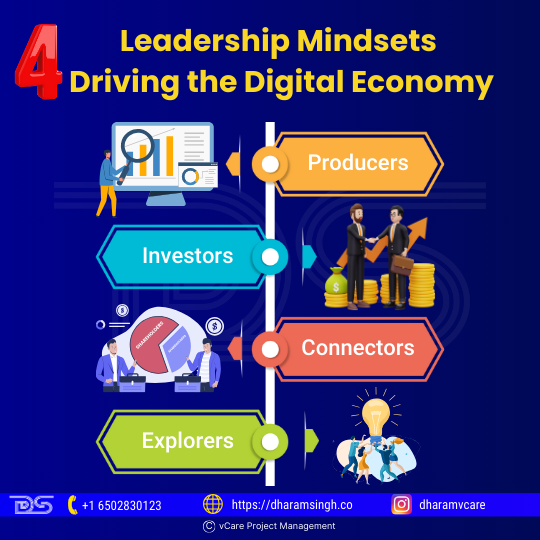
Leadership Mindsets Driving the Digital Economy
- Producers
The producers’ mindset blends with creating consumer value, emphasizing analytics, digital savvy, execution, and outcomes. Producers use analytics to expedite innovation that addresses shifts in customer preferences and enhances customer and user experiences.
- Investors
Leaders with an investor mindset seek a purpose for their firm beyond improving shareholder returns. They are committed to growth but in a sustainable way. They are concerned about the areas in which they operate, their personnel’s welfare, and ongoing development. They focus on increasing the value of their clients rather than treating them as money sources.
- Connectors
Leaders with a connector’s mindset see that mastering connections and networks is the new currency driving corporate performance in the new economy. Connectors understand this fundamentally. It’s how they work. They constantly bring various stakeholders from within the organization and ecosystem partners together. Connectors recognize the importance of building a feeling of community and belonging, which is especially vital in today’s fast-paced, breakneck-speed world when losing contact with the human touch is too easy.
- Explorers
Leaders with an explorer’s mindset are curious and innovative and thrive on ambiguity. They constantly experiment and learn by listening to a wide range of voices. Establishing behavioral standards encouraging risk-taking and failure, reverse mentorship, and a deep curiosity about how new forces shape the competitive environment are strong indicators of an explorer’s attitude.
Final Thoughts
Project management is a demanding task requiring effective leadership styles and traits for the project’s overall success. Successful project leadership involves team building, adaptability, communication, and effective planning skills. As a result, leaders play a fundamental and crucial role in project management since their approach decides whether a project will succeed or fail.
Project management is different from leadership. Successful project managers may need to be more effective leaders. However, they can learn leadership qualities and become successful leaders. In today’s firms, competent project managers must also be strong leaders. Successful project managers may use their innovative and creative capabilities to assist them in acquiring leadership skills that will complement their project management abilities by recognizing the difference between project management and leadership and adopting the road to becoming influential leaders.
The common component of project management and leadership is the standard by which the project manager and leader’s performance is judged. A project manager’s success and a leader’s effectiveness are evaluated in terms of the performance of the followers—the team’s performance. As a result, improving project managers’ leadership skills with an emphasis on abilities to increase team performance should be a key factor.
Leadership is critical in project management and must be balanced. It impacts project success and the value offered to the organization. The good news is that the finest project management training incorporates leadership concepts, providing employees with a well-rounded understanding of what it takes to lead a project.
With advanced certifications like PMP®, Agile, PgMP®, and PfMP® certifications, one can develop project management skills, be a good problem solver, be a more competitive candidate for positions, and be a successful project leader. In today’s competitive business world, one must be skilled and experienced to succeed and grow their career.
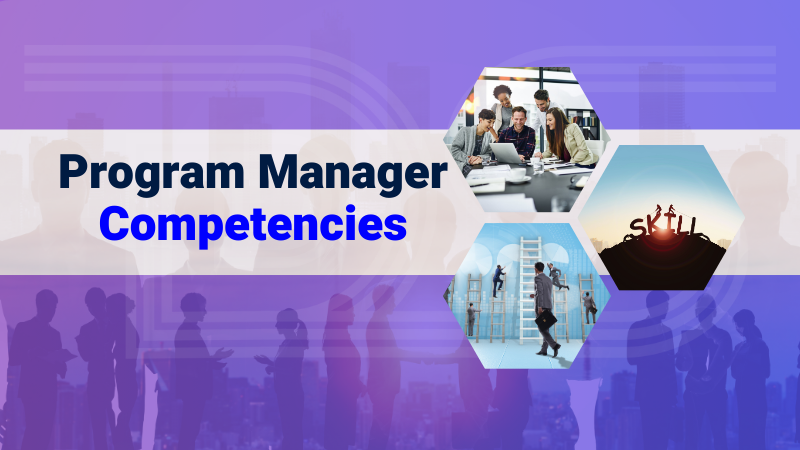
by DharamCW | Aug 1, 2024 | General
Today’s organizations are structured through many time-limited programs that transform organizational strategy into action. These programs necessitate a visionary mindset to align program goals with the organization’s strategic objectives. While project managers direct project work, they ensure individual projects align with program goals. Thus, program managers see their role as strategic and play an important role in managing the implementation of the organization’s strategic objectives by ensuring that the overall mission is met through the successful completion of planned programs.
Core Competencies of Program Managers
There are many similarities between a good program manager and a good project manager. However, a program manager must have broader organizational knowledge than a project manager. In addition, programs frequently necessitate strategic visioning and planning skills to align overall program goals and benefits with the organization’s long-term goals.
Here are the top ten core competencies of Program Managers:
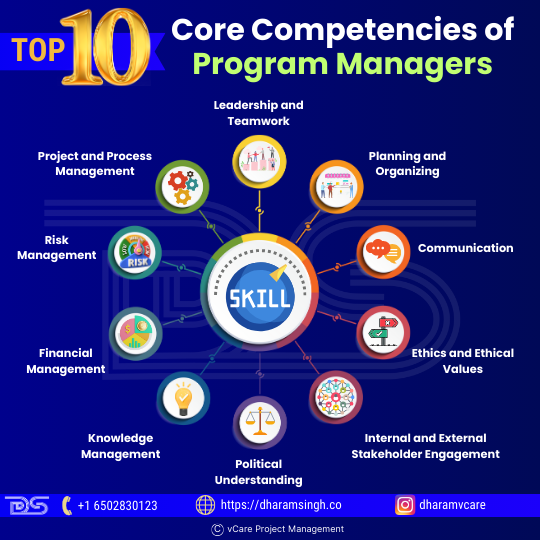
Top 10 Core Competencies of Program Managers
1. Leadership and Teamwork
The program manager is the team’s leader and is accountable for the program’s overall success. As a result, it is critical to have a clear vision and the ability to communicate it effectively to all employees, whether charismatic, supportive, or inspiring. The program manager’s strong leadership provides direction, builds morale, and inspires the program and project teams.
As the team leader, the program manager is responsible for engaging all team members and fostering collaboration, individual commitment, and accountability. A program manager must decide which tasks can be assigned and who can delegate them. Understanding what to delegate and how to delegate is critical.
2. Planning and Organizing
Programs frequently necessitate strategic visioning and planning skills to align overall program goals and benefits with the organization’s long-term goals. Therefore, the program manager must be skilled at planning and organizing for the best outcomes. Aside from the program schedule, creating a Work Breakdown Structure (WBS) for the program at the summary level is critical. It also allows control accounts to manage cost, schedule, and scope. In addition, a well-designed Work Breakdown Structure (WBS) helps organize the team at the start of a program and makes change management easier.
3. Communication
A program manager must be a good communicator. Effectively moving information between project resources is critical to a program’s success. To ensure the success of the team and project, the program manager must be able to negotiate effectively and use persuasion when necessary.
Thus, effective communication entails breaking down barriers within and across projects and functional departments.
Communication “hard skills” include gathering and disseminating performance data, such as status reports, progress measurements, and forecasts. In addition, the program manager must communicate effectively with the program and project teams, top management, and stakeholders. For the project’s success, vertical and horizontal communication must be fluid and transparent.
4. Ethics and Ethical Values:
One of the key aspects of effective program management is ethics.
The Code of Ethics & Professional Conduct emphasizes ethical values such as trust, honesty, accountability, respect, and fairness—these five values foster team harmony and professionalism, which leads to project success. Building trusting relationships across cultures, time zones, teams, and departments aids in the smooth operation of projects.
Trust is the common thread that connects different cultural differences, disparate work cultures spanning multiple time zones, team members with different behaviors, and departments with distinct objectives. A project leader must grasp this and cultivate trustworthy relationships.
Treating people fairly and demonstrating responsible, ethical behavior toward subordinates creates a working environment where employees feel safe, protected, and confident that there is no room for injustice or discrimination.
5. Internal and External Stakeholder Engagement
The program manager must be able to focus on both internal and external stakeholders simultaneously. Identifying and documenting all individuals or organizations impacted by the program and its projects and pertinent information about their interests and involvement significantly impacts program and project success. This process enables dealing with internal stakeholders (other project managers, senior managers, and the like) and external stakeholders (other agencies and regulators).
6. Political Understanding
Another skill that the program manager must have is the ability to understand the organization’s political environment. This understanding includes the political aspects of networking and strategic thinking to make the best decisions. With a solid understanding of the political environment, the program manager must form positive relationships to realize the program’s full benefits when the activities are transitioned to gain leverage and buy-in for overall program success. According to PMI’s The Standard for Program Management, well-managed stakeholder expectations and established buy-in can ensure program success. Knowing the firm’s working dynamic and environment is critical to the program manager’s success.
7. Knowledge management
A successful program manager should have a solid understanding of the organization and its business practices and familiarity with the technologies used in the program’s projects. In addition, program managers must have “hard skills” such as technical expertise and detailed cross-functional knowledge. This knowledge keeps the PM from being unduly influenced by functional experts who either have a plan or make decisions based on limited information.
The program manager is responsible for interpreting, implementing, and reviewing program policies, procedures, and requirements and communicating these to all program team members and project managers.
8. Financial Management
In today’s environment of scarce and competitive resources, program managers must understand how to finance their programs with speed, economy, and efficiency. Program managers are in charge of budgeting and calculating the return on investment (ROI). Therefore, they must be familiar with the program’s financial aspects to keep the budget under control at all times. In addition, they will be required to make decisions that will directly impact the budget and ROI for all projects within the program; therefore, program managers must be knowledgeable about the financial issues involved.
9. Risk management
Program management works tirelessly to reduce business risk. However, a project with no risk has little potential for reward. Effective risk management necessitates identifying risks, assessing their potential for harm, and developing plans to address the threats. Program managers are in charge of gathering all risks from functional teams and leading the team through a risk analysis exercise to determine which risks are program-level and project-level.
The program risks are then classified and prioritized based on their potential impact on the program. Finally, a similar exercise is performed to mitigate project risks throughout the life cycle to reduce overall program risk.
10. Project and Process Management
Transitioning from project management to program management necessitates a greater emphasis on the horizontal domain and less on technical capabilities. This action requires the program manager to prioritize strategic efforts over tactical skills, which can be delegated. Therefore, the program manager must have excellent project and process management skills, ideally with prior project management experience.
Managing program complexity through efficient and effective project management is critical for program management. Program management imposes structure and provides a framework that breaks down the complexity of managing a group of dynamic, time-limited projects into more manageable and cost-effective elements. This framework is critical for planning, scheduling, budgeting, and quality control. In addition, a program manager with strong core project and process management competencies can successfully lead between and across multiple projects.
Leadership Styles for Future Project/Program Managers
One of the potential success factors for both program and project managers is leadership style. A project manager can become a great project leader by understanding leadership styles and their impact. As a result, the program and project managers must determine the best leadership style for each project team. Some of the most common project management leadership styles are:
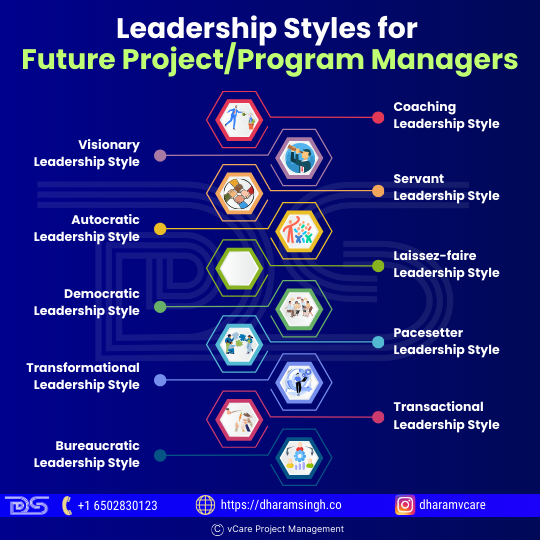
Leadership Styles for Future Project/Program Managers
1. Coaching leadership style
The coach’s leadership style is one of the most advantageous to employers and employees. But unfortunately, because it takes more time than other types of leadership, it is also one of the most underutilized.
2. Visionary leadership style
A visionary leadership style is advantageous for small, rapidly growing, and larger organizations undergoing transformations or corporate restructuring.
3. Servant leadership style
Servant leadership is an excellent leadership style for organizations of any size or industry, but it is especially common in non-profits. These leaders excel at boosting employee morale and reinvigorating employees’ interest in their work.
4. Autocratic leadership style
Autocratic leadership can benefit organizations with strict guidelines or industries that rely heavily on compliance. It can also benefit employees who require extensive supervision, such as those who need more experience. However, this leadership style can stifle creativity and make employees feel confined.
5. Laissez-faire leadership style
Unlike autocratic leadership, laissez-faire leadership focuses on delegating many tasks to team members and providing little supervision. Furthermore, because a laissez-faire leader spends less time managing employees, they often have more time to devote to other projects.
6. Democratic leadership style
The democratic leadership style is a hybrid of autocratic and laissez-faire leadership styles. Before making a decision, a democratic leader solicits and considers feedback from their team. This style is frequently credited with increasing employee engagement and workplace satisfaction because team members believe their voices are heard, and their contributions are valued.
7. Pacesetter leadership style
One of the most effective ways to achieve quick results is to set the pace. Pacesetter leaders are mainly concerned with performance, frequently setting high expectations and holding their team members accountable for meeting them.
8. Transformational leadership style
Like the coaching style, the transformational style emphasizes clear communication, goal-setting, and employee motivation. However, the transformational leader is motivated by a commitment to organizational objectives rather than putting most of one’s energy into each employee’s goals.
9. Transactional leadership style
A transactional leader, similar to a pacesetter, is laser-focused on performance. Under this leadership style, the manager establishes predetermined incentives, usually monetary rewards for success and disciplinary action for failure. However, unlike pacesetter leaders, transactional leaders are equally focused on mentorship, instruction, and training to achieve goals and reap the rewards.
10. Bureaucratic leadership style
Bureaucratic leaders, like autocratic leaders, expect their team members to adhere strictly to the rules and procedures. The bureaucratic style focuses on fixed duties within a hierarchy. Each employee has a set list of responsibilities, and collaboration and creativity are not required.
Adapting Agility during Digital Transformation
Thriving in today’s competitive environment is a difficult task. Businesses must find ways to keep up with the trends as almost every industry is rapidly evolving, fueled by technological advances. As a result, many adopt an agile mindset to remain sustainable and efficient.
The ability of a company to change or adapt quickly to market changes is referred to as business agility. The idea is to manage operations and resources flexibly and responsively to maximize business value. Concurrently, digital transformation is upgrading business processes using modern technologies to improve performance and overall efficiency.
Based on the agile project management philosophy, the business approach is gaining traction among forward-thinking organizations. It enables them to recognize and capitalize on potential opportunities ahead of the competition. Companies concentrate on three key areas for improvement:
• Strategy
• Organization
• Operations
Business agility is no longer an option in the age of digital transformation. Instead, it is an essential component of any successful business. As technology changes the world at breakneck speed, the program manager must be adaptable and develop alongside it.
Are Program Managers adapting to the agile environment?
Traditional project management entailed following a pre-defined plan to achieve pre-defined goals. However, in an agile environment, the concept of “done” is rapidly becoming obsolete. So, what does it take to manage projects effectively with constantly shifting requirements?
• Managers must first understand their organization’s goals when implementing agile workflows.
• Following that, they must reconsider their success metrics: rather than meeting a predetermined budget, timeline, or scope of work, project managers should focus on metrics such as development cycle time and the proportion of decisions made based on objective data.
• Finally, agile project managers must continuously examine their processes and seek to adapt and improve themselves to meet the evolving needs of their customers and coworkers.
Skills for a Hybrid Working Environment
Flexibility takes many forms as the world enters the “new normal” of business. However, the new flexible work models present some difficulties. To be successful in hybrid work, specific skills are required. Here is a list of five skills to concentrate on as you prepare for the new work environment.
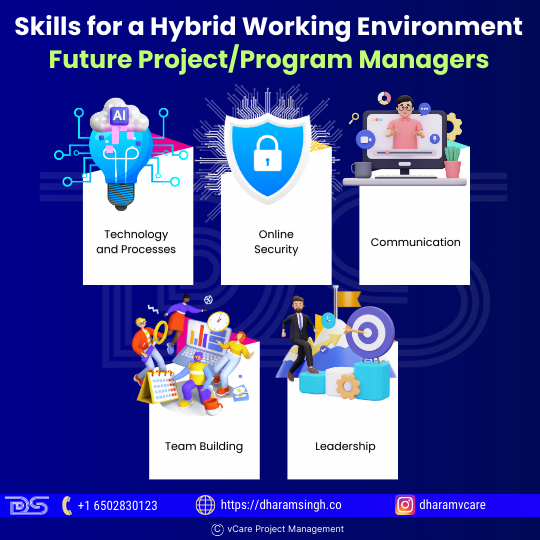
Skills for a Hybrid Working Environment
1. Technology and Processes
2. Online Security
3. Communication
4. Team-Building
5. Leadership
Every organization’s flexible work patterns look different. Additionally, there is no “one-size-fits-all” approach to implementing a hybrid work model. But, regardless of the circumstances, one thing is certain: training will be critical to your success.
Relevant information is critical. The right delivery methods are also important if you want them to stick. Finally, reaching and engaging your employees is critical to providing meaningful training. Use the best digital solutions to level the playing field for both in-office and remote employees. No matter where your employees are, the right approach will set them up for success.
Significance of Upskilling Project/Program Managers
Project/Program managers are valuable professionals who can work in various industries. It is frequently a highly sought-after position with numerous responsibilities. According to a study by PricewaterhouseCoopers, project management is critical to business performance and organizational success for 97% of organizations.
To ensure that a project management career takes off, one must have a mix of technical and soft skills. The top eight skills are listed below.
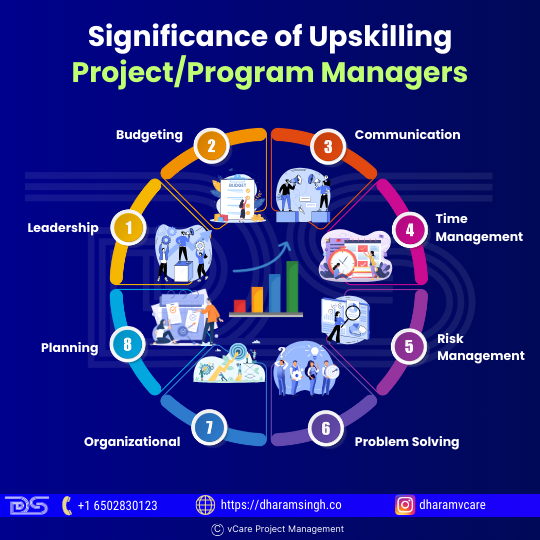
Significance of Upskilling Project/Program Managers
• Leadership
• Budgeting
• Communication
• Time Management
• Risk Management
• Problem Solving
• Organizational
• Planning
The world of project and program managers has changed significantly in the last few decades, with increased competition and the drive for efficiencies forcing companies to work differently. As project managers advance in their careers, they gain experience managing multiple related projects and making decisions that advance strategic and business objectives. As employers seek program managers to support the organization’s strategic goals, PgMP® credential holders will have a distinct advantage in employment and promotion opportunities over their peers.
How PgMP aids in gaining program managers’ knowledge
The Program Management Professional (PgMP®) certification is a visible indication of advanced experience and skill. As a result, it gives one distinct advantage in employment and promotion. As on 6th June 2024, there are 6,358 PgMP® that exist worldwide. The PgMP® is intended for professionals who have advanced in their careers and can manage multiple projects to ensure the success of a program. Furthermore, PgMP® holders are expected to manage complex tasks across multiple organizations, geographic locations, and cultures.
PgMP® Certification Benefits
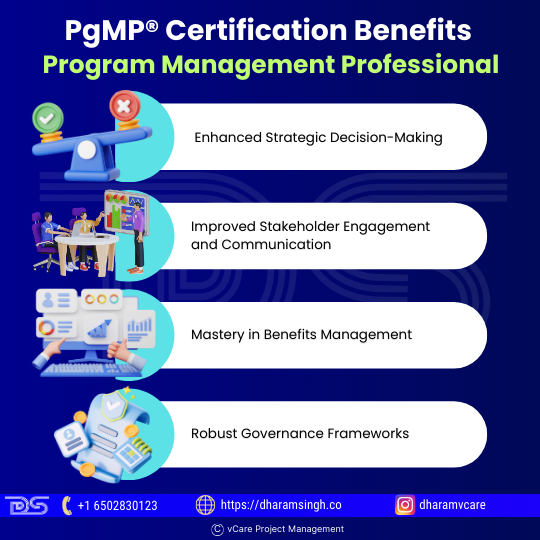
PgMP Certification Benefits
Enhanced Strategic Decision-Making:
The PgMP® certification equips program managers with the skills to make strategic decisions that align with organizational goals, ensuring the successful integration and delivery of multiple projects.
Improved Stakeholder Engagement and Communication:
Certified PgMPs are trained to effectively engage and communicate with stakeholders at all levels, fostering trust and ensuring stakeholder needs are met throughout the program lifecycle.
Mastery in Benefits Management:
Gain expertise in identifying, planning, and realizing program benefits, ensuring that the program delivers measurable value to the organization and its stakeholders.
Robust Governance Frameworks:
Learn to develop and implement robust governance frameworks that ensure program alignment with strategic objectives, risk management, and compliance with organizational standards.
Also, while preparing for PgMP® Certification, you will learn the best practices for conducting your programs more efficiently and achieving great results for your organization. This aspect might assist you in securing better pay and a higher position. In addition, you will be recognized as a certified program manager.
Final Thoughts
Program management will only be effective if the anticipated benefits are realized and effective leadership is at the top. Often, programs fail to achieve the organizational goal due to a lack of management skills in dealing with the program’s complexity and demand. Competence and skills are entirely different concepts, with skills acquired through training and competence referring to the level of proficiency in applying the acquired skills. The skills and competencies of a program manager and a project manager are similar. Still, those of a program manager are expected to be deeper and much more strategic in aligning a series of projects.
When program managers use their unique perspectives and insight to guide programs in the most strategically advantageous way, they can provide long-term value for the company’s vision and direction. Any organization that manages more than one project at a time will benefit from the assistance of a program manager.

by DharamCW | Nov 9, 2021 | Project-Program-Portfolio Management Knowledge
What is a Project?
PMI defines endeavour as “a temporary endeavor undertaken to create a unique product, service or result”. Projects give an organisation focus to excel. “Project” is a huge, broad word that has such rich possibilities in terms of helping define how people do what they do and how organisations achieve their goals, create change, and deliver value. We shouldn’t think of projects by their features or attributes but on what needs to be done and figure out the best way to do it. It is expected that by 2027, employers will need approximately 87.7 million individuals working in project management-oriented roles.
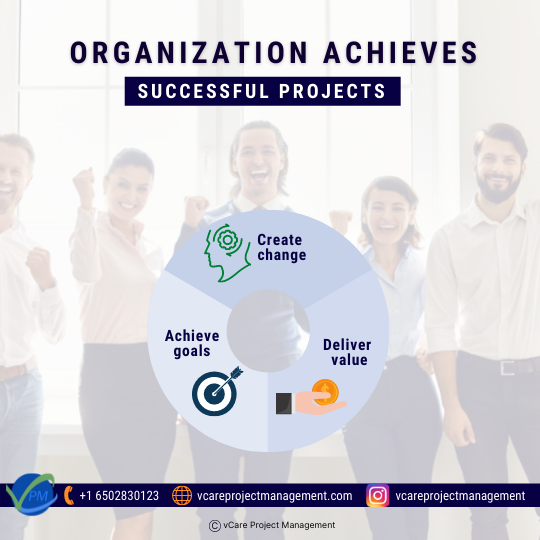
Successful projects
Everyone has a project. People have projects on behalf of themselves and on behalf of others; they have their projects, and they have collective projects. We do projects at school, and we carry out projects at work. Add to that all our spare time projects, and how it is sometimes hard to tell work projects from spare time projects. Projects cut across. (Jensen, 2012)
What is project economy?
PMI defines project economy as a Paradigm shift in the business world toward using projects to handle work and solve problems. It emphasises that organisation in general needs project leaders who can help to manage real-world challenges. The Pulse of the Profession report well backs this aspect.

The Need for Project Economy
The Need for Project Economy: Changing Scenario
Projects with unique objective induce a change in the organisation and society at large. The project approach takes all the stakeholders in the process of obtaining the project objective. Project managers are required to be inclusive, and they cannot take a parallel approach. The project economy drives this change.
Though the management thinkers like Frederick Taylor, Henry Ford, Dr William Edwards Deming recommended continuous improvement of the business’s operations, these improvements were considered projects and executed as projects. Advancements in computing and technology have driven operational excellence at the core. Yet, disruptive technologies and the speed of technology growth drive differently, and it calls for many projects. Projects are seen as a new norm for creating value and help organisations to stay ahead in the curve.
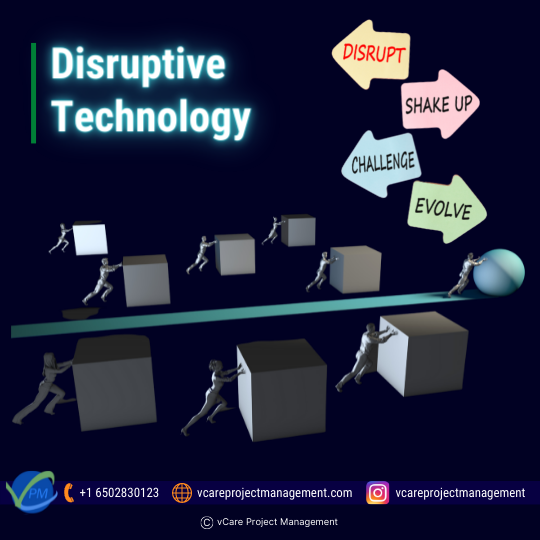
Disruptive Technology
Project work has been seen as more administrative and seen as a low value from the frontline of the management due to extensive documentation and paperwork. Rationale, business Case and benefits were not given sufficient importance in project management methodologies. As the technology and tools for collaboration are fast-changing, agile triggers, project aspects like “Working software over documentation”, “individual interactions over process and tools”, etc., are largely adopted. Technology and engineering help bespoke run the project, making the project managers at the centre of the process. With automation taking over, projects are becoming a critical part of the organisation. Now everything around the people lives are becoming projects, and this fact can be emphasised with every professional’s career as a good example.
People keep track of changes from previous jobs, recording and sharing their learnings. They move from one job to another compared to previous situations where people stuck to one job for a longer tenure. As they move to different companies, the learning is multi-fold and its applied cutting across domains enriching experience.
As organisations are growing more in complex and chaotic environments, “Project Oriented Methodology” helps define action and helps manage change appropriately with a specific set of goals. Project management methods help to improve the performance of individuals and teams.
Monitoring and assuring the quality through projects help us assess its value and deliver it. Project management strategies help to keep costs on budget and reduce the risk of budget overrun. Learning lessons from failure and being agile helps to adapt. Project professionals play a pivotal role in managing the projects and contribute with the right blend of technical and people capabilities. Hence projectification would be the future order, reiterating the fact, where it is expected that employers will need around 87.7 million project management professionals by 2027.
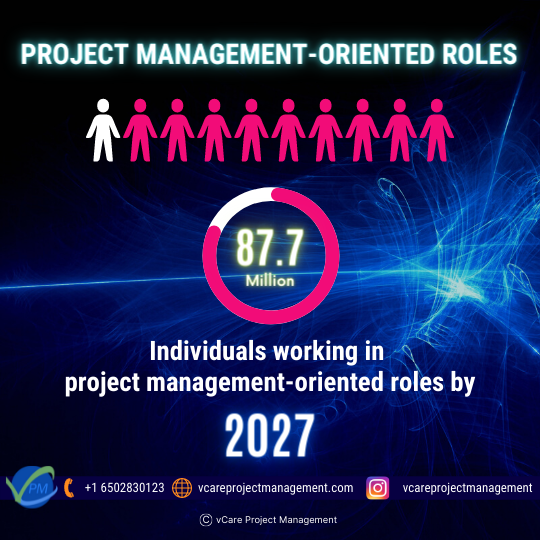
Project Management-Oriented Roles
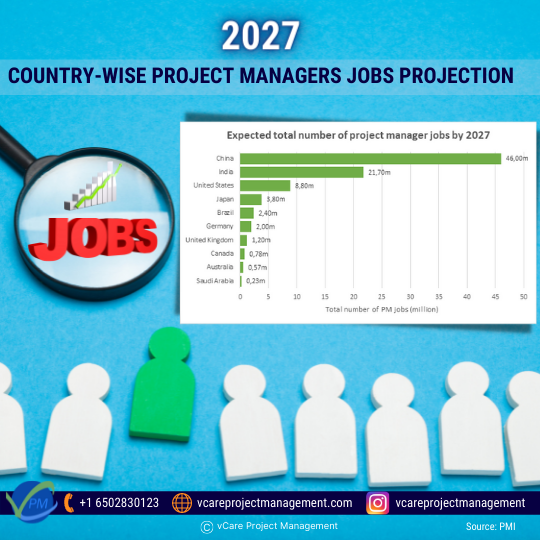
Country-wise Project Managers Jobs Projection
What is Projectification?
Projectification, the term was introduced by Christophe Midler in 1995 in his research paper “Projectification of the Firm: the Renault Case”. In this, he analysed the relationship between project management and organisation, with a case study of “Renault” on “Projectificiation”, an organisation undergoing a four-phased transition from the 1960s. This study is believed to be a construct of project orientation taken from the novel management approach “Management by Projects” by Gareis in 1989.
“The Project Revolution- How to succeed in a project Driven World”
In the book “The Project Revolution- How to succeed in a project Driven World”, Antonio Nie recommends a Project canvas composed of 14 dimensions that are capable of influence and determine project success across four domains:
- Why?
- Why is this project taken up?
- What is the purpose and passion behind the rationale?
- Why successful implementation important?
- Who?
- Who is accountable?
- Governance of resources and delivery
- What, How and When?
- Details of Definition, Design, Plans, Milestones, Cost, Risk, etc.,
- Power Skills: Empathy, Motivation, Change management, Communication.
- Where?
- Culture
- Prioritisation
- Organisation context
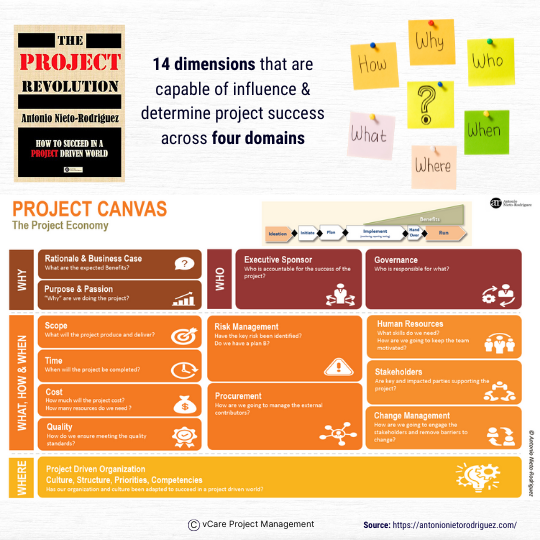
The Project Revolution
Check out my discussion on this topic with Reinhard Wagner in YouTube
You can subscribe and follow my podcasts and interviews with Project Management Experts on YouTube at https://bit.ly/2NDY8wd
You can subscribe to vCare Project Management YouTube Channel to catch future videos of our Q&A series and certification success stories using the link https://bit.ly/2YF0wJl
For any questions related to Project Management career, training, and certifications, you can book an obligation free 15 minutes session with me by visiting talktodharam.com
Conclusion
Projectification is becoming the order of the day, and it’s going on increasing trends. As a project manager or project professional, it’s important to understand how organisations, government and stakeholders are evolving. The disruptive changes happening in technology and rapid growth is influencing many facets of project management. As project professional, as we start manoeuvring them, we can create value for others and us for a better world.






















Recent Comments